Fresh salsa is more than just a dip — it’s a burst of flavor, culture, and color in every bite. Whether you’re spooning it over tacos, scooping it with chips, or using it to brighten up grilled meats, a fresh salsa recipe brings life to your meals in a way no store-bought jar can. The charm of salsa comes from its simple ingredients and endless versatility. With just a few core ingredients and a bit of know-how, you can create a customized salsa that rivals the best you’ve ever tasted.
But what really makes a salsa “fresh”? It’s not just about raw ingredients. It’s the vibrant flavor that comes from hand-picked tomatoes, the kick from a just-cut chili pepper, and the zing from freshly squeezed lime juice. Whether you prefer your salsa chunky, smooth, mild, or fiery, mastering the art of homemade salsa opens the door to endless creativity in the kitchen.
In this detailed guide, we’ll walk you through everything you need to know about making fresh salsa — from choosing the right produce to storing it properly, avoiding rookie mistakes, and experimenting with global twists. Ready to dip in? Let’s get started.
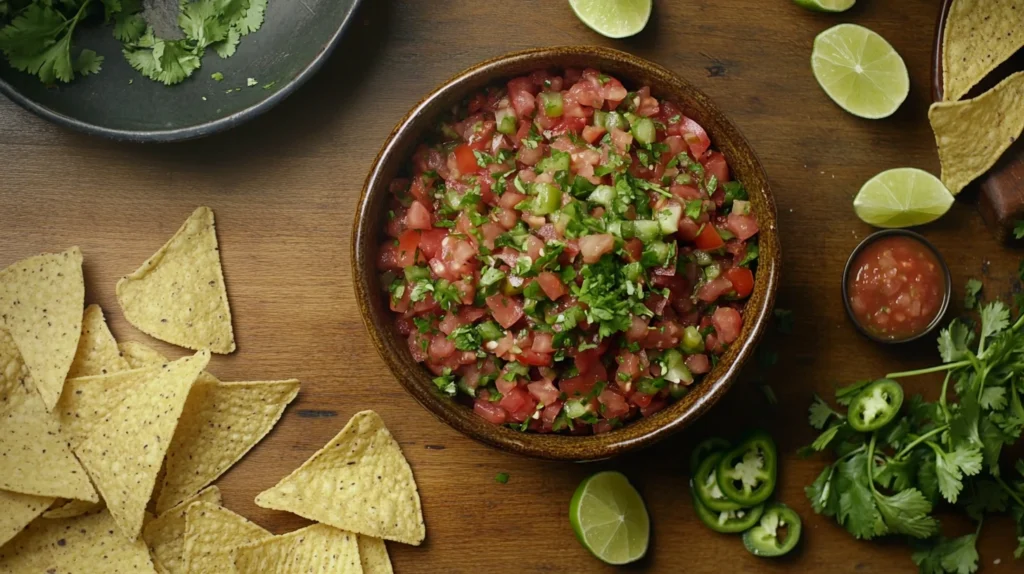
Ingredients for a Fresh Salsa Recipe
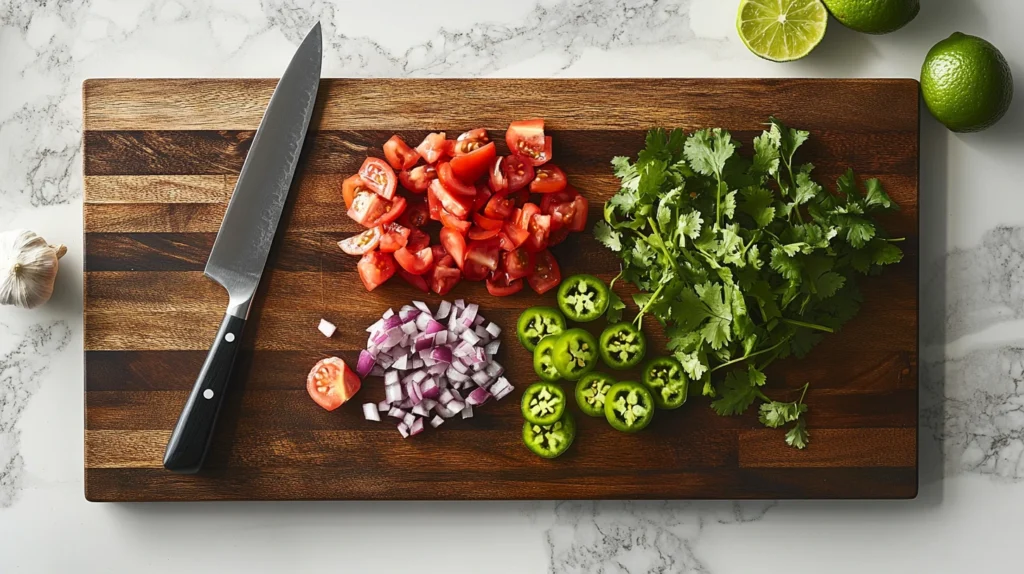
Creating an irresistible fresh salsa starts with choosing the right ingredients. While the classic tomato-based salsa is the most popular, the real secret lies in the freshness and balance of your ingredients. A great salsa is all about layers of flavor — sweet, spicy, tangy, and savory — all working together in harmony.
Essential Ingredients in a Fresh Salsa Recipe
A traditional fresh salsa recipe usually includes a few key staples. These form the flavorful foundation of the dish:
- Tomatoes: Ripe, juicy tomatoes are the heart of most fresh salsas. Roma tomatoes are a great choice because they have less water and a deeper, more concentrated flavor. Cherry or heirloom tomatoes can also add a unique sweetness.
- Onions: White onions offer a punchy bite, red onions bring a sweeter note, and yellow onions provide a balance in between. Choose based on the overall profile you want.
- Garlic: Raw garlic delivers a sharp depth of flavor. For a more mellow touch, roast it before adding.
- Chili Peppers: Jalapeños are a classic choice, offering moderate heat. Serrano peppers pack more punch, while habaneros are for the truly brave. Deseed for less heat.
- Cilantro: Fresh cilantro adds a citrusy, herbal kick. It’s essential for that authentic salsa flavor — unless you’re one of the unlucky few who taste soap!
- Lime Juice: Freshly squeezed lime juice brightens up the entire dish. It also helps balance acidity and preserve the salsa for a bit longer.
- Salt and Pepper: Don’t overlook seasoning. Just a pinch of sea salt can enhance every other flavor in your salsa.
These ingredients not only bring their own unique notes but also help balance and intensify each other’s flavors when mixed.
Want to pair this salsa with other crowd-pleasing dips? Try the Queso Blanco Dip recipe — warm, cheesy, and perfect for parties.
Flavorful Add-Ins to Enhance Your Homemade Salsa
Looking to spice up your salsa a bit? These ingredients can be added in small amounts to tweak flavor, texture, and visual appeal:
- Cumin: A tiny pinch adds warm earthiness and depth.
- Green Onions or Scallions: Great for adding color and a mild onion flavor.
- Bell Peppers: Red or yellow bell peppers bring sweetness and crunch.
- Radishes: Thinly sliced radishes can add bite and a peppery twist.
- Fruit: Yes, fruit! Mango, pineapple, and even watermelon can add a sweet contrast to the spice.
- Avocado: Diced avocado adds creaminess and makes your salsa more filling.
By mixing and matching these add-ins, you can take your fresh salsa from basic to restaurant-quality in no time.
How to Choose the Best Produce for Your Fresh Salsa
Since freshness is everything in a raw salsa, picking the best produce is critical. Here are a few tips to keep in mind:
- Go for seasonal: Use produce that’s in season for peak flavor and better prices.
- Steer clear of overly ripe tomatoes—they might seem appealing but can make your salsa watery and less flavorful.
- Check firmness and smell: Good ingredients will feel firm to the touch and smell fragrant — particularly herbs like cilantro.
- Wash thoroughly: Even if you’re peeling or chopping them, always rinse your vegetables under cool water to remove any dirt or pesticide residue.
Taking the time to hand-pick your ingredients makes a noticeable difference in the taste and texture of your salsa.
Tools for Making a Fresh Salsa Recipe at Home
While making fresh salsa doesn’t require a fancy kitchen setup, having the right tools on hand can make the process smoother, quicker, and more enjoyable.
Basic Kitchen Tools You Need for a Fresh Salsa Recipe
Here’s a list of must-have items for preparing fresh salsa with ease:
- Cutting Board: A large, non-slip board gives you plenty of room to prep ingredients safely.
- Chef’s Knife: A sharp, reliable knife is crucial for chopping vegetables quickly and accurately.
- Mixing Bowl: Use a medium to large mixing bowl to combine all the ingredients evenly.
- Citrus Juicer or Reamer: Fresh lime juice is key, and a juicer ensures you get every drop without seeds.
- Measuring Spoons: For salt, pepper, lime juice, and any optional seasonings you want to control.
Optional Gadgets to Upgrade Your Salsa Game
While not required, these tools can make the job faster or more fun:
- Food Processor: Perfect if you prefer a smooth salsa or are making a large batch quickly.
- Blender: Similar to a food processor, but it may puree ingredients more thoroughly — great for salsa roja.
- Garlic Press: A fast way to extract the full flavor from garlic without mincing.
- Herb Scissors: These are excellent for cutting cilantro or green onions finely without bruising them.
With these tools at your disposal, crafting fresh salsa becomes efficient and enjoyable, whether you’re cooking for two or prepping for a party.
Step-by-Step Fresh Salsa Recipe Guide
Now let’s walk through the entire process of creating a delicious, balanced, and flavorful salsa that’s ready in under 15 minutes.
How to Prepare Ingredients for a Fresh Salsa Recipe
Start by washing and prepping your ingredients:
- Tomatoes (4 medium) – Rinse, core, and dice. For a chunkier texture, deseed and drain slightly.
- Onion (½ large or 1 small) – Finely chop. Red onion offers a hint of sweetness and vibrant color.
- Chili Pepper (1 jalapeño) – Slice in half, remove seeds for less heat, then finely dice.
- Cilantro (¼ cup, chopped) – Remove thick stems, then finely chop the leaves.
- Garlic (1 clove) – Mince finely or use a garlic press.
- Lime (1, juiced) – Roll on a hard surface before cutting to release more juice.
- Salt (½ tsp) and Pepper (to taste) – Adjust based on your preference.
You can also prep add-ins like diced mango, avocado, or corn at this stage if you’re customizing your salsa.
Blending vs. Chopping – What’s Best for Homemade Salsa?
- Chopped Salsa: Offers a chunkier, rustic texture. Ideal for scooping with tortilla chips and as a taco topping.
- Blended Salsa: Smoother and more liquid. Great for pouring over grilled meats, eggs, or mixing into rice bowls.
👉 Pro Tip: Pulse ingredients in a food processor 3–4 times for a perfect balance of smoothness and texture. Avoid over-processing to prevent a soupy consistency.
Perfecting the Flavor in Your Fresh Salsa Recipe
After combining all ingredients:
- Taste your salsa right after mixing.
- Add more salt or lime juice as needed.
- Want more heat? Dice up a second chili or include the seeds.
- Chill for 10–15 minutes before serving — this helps flavors meld beautifully.
Letting the salsa sit, even briefly, enhances flavor significantly. You can also prep it the day before for an even deeper taste.
Creative Variations of a Fresh Salsa Recipe
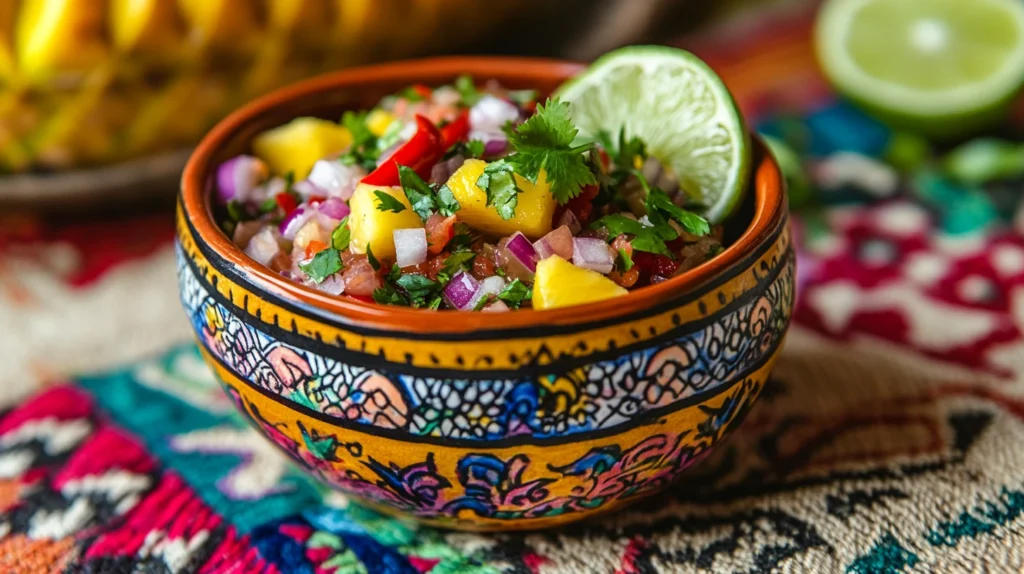
Fresh salsa is incredibly versatile. Once you’ve mastered the classic version, the real fun begins — experimenting with different flavor profiles, textures, and ingredients. Below are some popular and creative variations that cater to various tastes and occasions.
Spicy Tomato Salsa Variation
For heat lovers, this version turns up the spice while maintaining the traditional tomato base.
- Base: Roma or plum tomatoes, red onion, garlic, lime juice.
- Heat source: Add extra jalapeños or swap them for serrano or habanero chilies.
- Flavor Boost: A touch of smoked paprika or chipotle powder enhances the intensity.
👉 Best served with grilled meats, tacos, or breakfast eggs.
Mango & Pineapple Twist on a Fresh Salsa Recipe
This tropical twist combines sweetness and acidity, making it ideal for summer dishes.
- Base: Diced mango, fresh pineapple chunks, red onion, cilantro, lime juice.
- Optional Add-ins: Jalapeños for heat, mint leaves for coolness.
- Flavor Profile: Sweet, tangy, and a little spicy.
👉 Delicious with seafood like grilled shrimp, mahi-mahi, or tilapia.
Avocado Salsa for a Creamy Fresh Salsa Option
Creamy and nutrient-rich, avocado salsa is a crowd-pleaser with a smoother texture.
- Base: Ripe avocados, diced tomato, onion, garlic, lime juice.
- Texture Tip: Mash the avocado slightly for a creamier feel, or dice it for a chunky salsa.
- Fresh Add-ons: Corn, black beans, or roasted poblano peppers.
👉 Great as a dip or spread on toast, burritos, and sandwiches.
Corn & Black Bean Fresh Salsa Variation
Hearty and satisfying, this version works well as a side dish or topping.
- Base: Cooked corn kernels, canned (drained) or cooked black beans, red bell pepper, onion, lime juice.
- Flavor Tip: Add ground cumin and chopped cilantro for an earthy balance.
- Bonus Add-ins: Avocado, jalapeños, or chopped tomatoes for added flair.
👉 Pair it with tortilla chips, rice bowls, or grilled chicken.
Tips to Perfect Your Fresh Salsa Recipe
Making fresh salsa isn’t just about following a recipe — it’s about finding the right balance of flavors and achieving that perfect texture. These expert tips will help you create salsa that’s not only fresh but unforgettable.
Balancing Flavors in Your Fresh Salsa Recipe
- Too tangy? Add a pinch of sugar or a splash of orange juice.
- Too sweet? Increase lime juice or add a little extra salt.
- Flat flavor? Often fixed by just a bit more acid (lime) or salt.
👉 Always adjust after chilling your salsa, as the flavors intensify over time.
How to Get the Right Salsa Texture
Texture is key — no one wants watery or overly mushy salsa. Here’s how to keep it just right:
- For chunky salsa: Dice tomatoes finely and drain excess juice.
- For smoother salsa: Use a blender or food processor, but don’t overblend.
- Prevent wateriness: Remove tomato seeds or let diced tomatoes drain for 5–10 minutes before mixing.
Why Marination Time Improves Your Salsa
Letting your salsa rest before serving allows all the flavors to come together:
- Minimum: 10–15 minutes at room temperature.
- Best: 1–2 hours in the fridge before serving.
- Storage tip: Store in an airtight container to keep it fresh and reduce oxidation.
👉 Pro tip: Salsa tastes even better the next day — the ingredients have more time to marry and develop deeper flavor.
Avoid These Mistakes When Making a Fresh Salsa Recipe
Even a simple fresh salsa recipe can go wrong without the right tips. Avoiding these common mistakes ensures you get bold, vibrant flavor every time.
Over-Blending Can Ruin Your Salsa
It’s tempting to toss everything in a blender and hit “go,” but that can quickly turn your salsa into soup.
- Why it’s a mistake: Over-blending creates a runny texture and can dull the flavor.
- Fix it: Use short pulses in a food processor or hand-chop your ingredients for better control over texture.
Say No to Canned Ingredients in a Fresh Salsa Recipe
Fresh salsa thrives on freshness. While convenient, canned ingredients can compromise flavor.
- Canned tomatoes: Often too watery and lack the natural sweetness of fresh ones.
- Canned chilies: Lose their crispness and can have a metallic taste.
👉 Always choose fresh produce whenever possible. It makes a big difference in both taste and appearance.
Proper Storage Keeps Your Salsa Fresh Longer
Storing salsa the wrong way can lead to early spoilage or a loss of flavor.
- Mistake: Leaving it uncovered in the fridge or keeping it too long at room temp.
- Solution: Store in a glass or BPA-free airtight container, and always refrigerate promptly after making.
How to Store Your Fresh Salsa Recipe Like a Pro
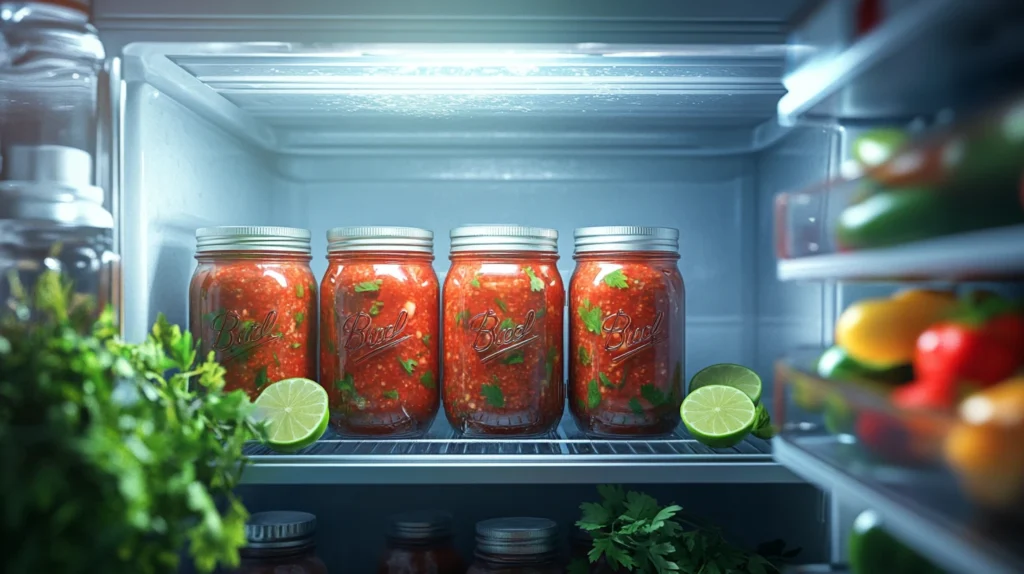
Whether you’re cooking for one or meal prepping for the week, this fresh salsa recipe fits right in.
Fridge Storage Tips for Homemade Salsa
- Shelf life: 3 to 5 days in the refrigerator.
- Best container: A sealed glass jar or airtight plastic container.
- To prevent oxidation, press a piece of plastic wrap directly onto the surface of the salsa before sealing the container.
👉 Stir before serving to recombine any separated liquids or settled bits.
Can You Freeze a Fresh Salsa Recipe?
Freezing is possible, but not ideal for all salsa types.
- Best for: Blended salsa with fewer watery ingredients.
- Texture change: Upon thawing, tomatoes and onions may become mushy.
- Freezing tip: Freeze in small portions and thaw in the fridge overnight before use.
If freezing, try roasted tomato salsa or cooked variants for better results.
How to Identify Spoiled Salsa and When to Throw It Out
To keep your family safe, here’s how to spot spoiled salsa:
- A sharp, off-putting smell—like sourness or fermentation—means it’s time to toss it
- Color change: Darkening or dull appearance means it’s past its prime.
- Texture: Excessive liquid separation or sliminess signals spoilage.
👉 When in doubt, throw it out. It’s not worth the risk.
Serving Ideas for Your Fresh Salsa Recipe
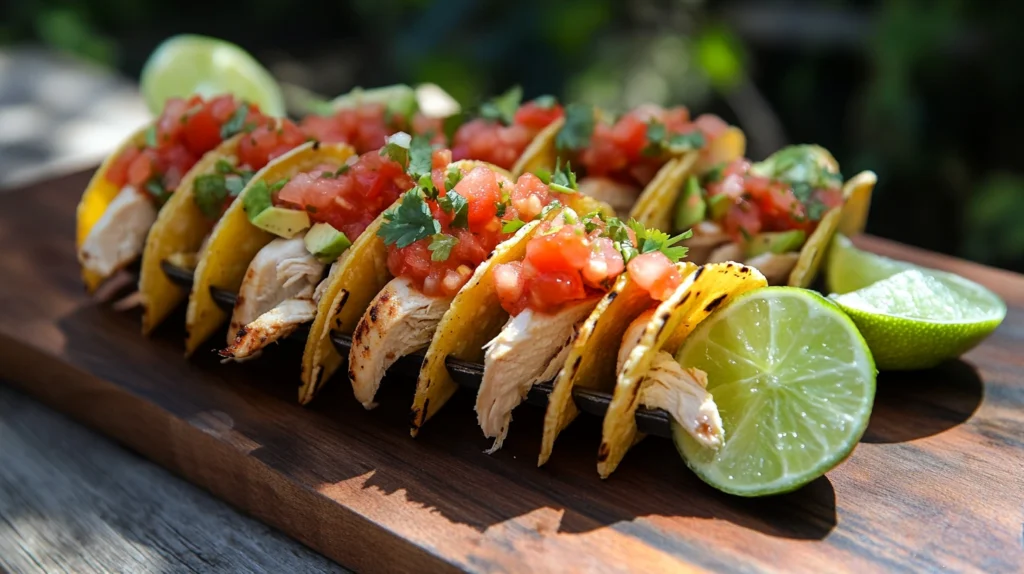
Fresh salsa is as versatile as it is delicious. Here are some creative and classic ways to use it:
Top Dishes to Pair with Fresh Salsa
- Tortilla Chips: The classic combo for parties and snacking.
- Grilled Meats: Adds brightness to steak, chicken, pork, or shrimp.
- Tacos & Burritos: Spoon it inside or on top for added zest and moisture.
- Omelets or Scrambled Eggs: A scoop of salsa transforms breakfast into something special.
- Rice Bowls: Adds flavor without the need for heavy sauces.
Creative Ways to Serve a Fresh Salsa Recipe
- Salsa Bar: Offer a few variations (mango, spicy, mild) for gatherings.
- Combine salsa with olive oil and a splash of lime juice to create a vibrant, zesty salad dressing.
- Salsa-Topped Baked Potatoes: A fresh, healthy topping for spuds.
- Salsa-Stuffed Avocados: Serve scoops of salsa in halved avocados for a quick appetizer.
These fun ideas can turn a simple side dish into a standout component of any meal.
Fresh Salsa Recipe Adaptations for Special Diets
The fresh salsa recipe is naturally flexible, making it perfect for a wide range of dietary preferences. Whether you’re vegan, low-carb, or following a keto lifestyle, this fresh salsa recipe can be easily adapted with simple ingredient swaps. Thanks to its use of wholesome, plant-based ingredients, you can enjoy a flavorful dip, topping, or side that aligns with your dietary goals—all without sacrificing taste.
Vegan and Plant-Based Fresh Salsa Recipe Tips
Most fresh salsa recipes are already vegan, but here are a few tips:
- Avoid: Processed sauces or spice blends with dairy or animal-based ingredients.
- Stick to whole foods: Fresh produce, herbs, and spices are 100% plant-based.
- Add richness: For creamier texture, add avocado or use a fruit base like mango.
Low-Sodium and Keto-Friendly Salsa Ideas
Watching your salt or carb intake? No problem:
- Low-sodium salsa: Reduce added salt and rely on lime juice and garlic for bold flavor.
- Keto-friendly salsa: Avoid fruit-based salsas and corn; stick to tomatoes, chilies, onions, and healthy fats like avocado.
Salsa is one of the rare condiments that can be both health-conscious and bursting with flavor.
Fresh Salsa Recipe for Weekly Meal Prep
Salsa can be your secret weapon for easy, delicious weekly meals.
How to Make Big Batches of Fresh Salsa
- Scaling: Double or triple the recipe for weekly use or large gatherings.
- Divide portions: Store in individual containers for quick grab-and-go snacks or toppings.
- Flavor improves: Salsa often tastes better after 1–2 days in the fridge.
Using Fresh Salsa in Multiple Meals
- Breakfast: Mix into scrambled eggs or top avocado toast.
- Lunch: Use in wraps, tacos, or Buddha bowls.
- Dinner: Spoon over grilled proteins or mix with cauliflower rice.
- Snacks: Enjoy with veggie sticks or whole grain crackers.
It’s a time-saving, flavor-boosting hack for anyone who meal preps.
International Takes on the Fresh Salsa Recipe
This fresh salsa recipe is perfect for anyone who loves bold, homemade flavors.
Traditional Mexican Pico de Gallo Recipe
- Also known as: Salsa fresca
- Texture: Chunky
- Ingredients: Diced tomatoes, onions, cilantro, lime juice, and chilies
- Use: Perfect with tacos, enchiladas, or grilled meat
Classic Salsa Roja and Salsa Verde Variations
- Salsa Roja: Made with red tomatoes, garlic, and chilies, often blended or roasted.
- Salsa Verde: Uses tomatillos instead of red tomatoes, offering a tangier taste.
These are staples in traditional and modern Mexican kitchens.
Global Twists on the Fresh Salsa Concept
- India: Fresh chutneys using tomatoes, mint, and spices
- Caribbean: Fruit-forward salsas with Scotch bonnets, mango, and lime
- Korea: Fusion salsas using gochujang or kimchi for heat and umami
Salsa’s essence — fresh, zesty, and adaptable — makes it a global favorite.
For a flavorful brunch spread, pair your fresh salsa with the bold and savory flavors of Shakshuka with Sourdough Breakfast — the rich tomato base complements salsa beautifully. And if you’re looking for a festive drink to round it out, the Spiced Cranberry Punch makes a zesty, holiday-inspired companion.
Frequently Asked Questions
What is the secret ingredient in homemade salsa?
The “secret ingredient” in many homemade salsas isn’t just one item—it’s fresh lime juice. This simple addition enhances the flavor of all the other ingredients, adds brightness, and brings balance between the acidity, sweetness, and heat. Some cooks also swear by a pinch of ground cumin or a splash of apple cider vinegar for added depth and complexity.
What are the ingredients in Fresh Is Best salsa?
While “Fresh Is Best” is a specific brand, the general idea behind its salsa is a focus on natural, preservative-free ingredients. A typical ingredient list includes:
- Fresh tomatoes
- Onions
- Jalapeño or serrano peppers
- Garlic
- Cilantro
- Lime juice
- Salt
- Optional vinegar for preservation
The key is using fresh, local produce and minimal processing to preserve texture and flavor.
What are the ingredients in a salsa?
Traditional salsa ingredients include:
- Tomatoes: The base of most red salsas.
- Onions: Typically white or red for sharpness or sweetness.
- Chilies: Jalapeños, serranos, or habaneros for heat.
- Garlic: Adds depth and pungency.
- Cilantro: Offers an herbaceous, citrusy balance.
- Lime juice: Brings freshness and acidity.
- Salt: Enhances the overall flavor.
Depending on the style of salsa, additional ingredients like corn, black beans, mango, or vinegar may also be included.
Do you need to peel tomatoes before making salsa?
Not always. If you’re making a fresh, chunky salsa, there’s no need to peel the tomatoes—especially if you’re using Roma or cherry varieties with thin skins. However, if you’re making a smooth or cooked salsa, peeling tomatoes can help achieve a better texture and avoid stray bits of skin in the final product.
Why do you boil tomatoes for salsa?
Boiling (or blanching) tomatoes helps to:
- Loosen the skins for easy peeling.
- Soften the flesh to blend more smoothly.
- Deepen the flavor, especially for roasted or cooked salsas.
It’s a common step for smoother, restaurant-style salsa or sauces that will be cooked or canned.
What happens if you don’t peel tomatoes for sauce?
Leaving the skins on won’t ruin your sauce or salsa, but it can affect the texture:
- Skins may curl up or stay tough after blending or cooking.
- In a smooth salsa, they may create a gritty or inconsistent texture.
- In a chunky salsa, the skin is usually less noticeable.
If texture matters and you’re aiming for a silky finish, it’s worth peeling the tomatoes.
Conclusion
Making your own fresh salsa recipe from scratch is not only easy and cost-effective, it’s also a flavorful way to enhance nearly every meal. Whether you’re keeping it classic with tomatoes and lime, exploring tropical mango blends, or customizing it for your diet, the possibilities are endless. With the right ingredients, tools, and a bit of practice, your salsa will become a kitchen staple that impresses family and friends alike.
So don’t settle for store-bought. Dive into your fridge, grab those ripe tomatoes, and whip up a bowl of vibrant, homemade goodness. Salsa isn’t just a dip — it’s a lifestyle.
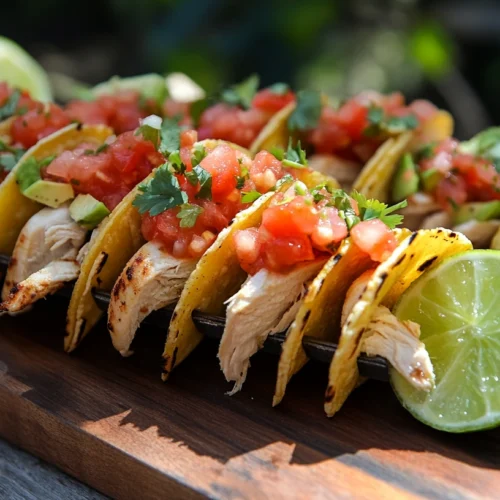
Fresh Salsa Recipe – Easy, Zesty, and Homemade
Equipment
- Cutting board
- Chef’s knife
- Citrus juicer or hand reamer
- Mixing bowl
- Food processor or blender (optional)
- Measuring spoons
Ingredients
- 4 medium ripe Roma tomatoes diced
- ½ medium red onion finely chopped
- 1 jalapeño pepper deseeded and diced (use serrano for more heat)
- 1 clove garlic minced
- ¼ cup fresh cilantro chopped
- Juice of 1 lime about 2 tablespoons
- ½ teaspoon sea salt or to taste
- ¼ teaspoon black pepper optional
- Optional: pinch of cumin chopped mango, avocado, or corn for variations
Instructions
- Prep Ingredients: Dice tomatoes, onions, jalapeño, and garlic. Chop cilantro and juice the lime.
- Mix: In a medium bowl, combine all ingredients.
- Taste and Adjust: Add more salt, lime juice, or chilies depending on flavor and spice preference.
- Chill (optional): Let sit for 10–15 minutes (or longer) for flavors to meld.
- Serve: With tortilla chips, tacos, or your favorite dish. Enjoy!
- Optional Method: For smoother salsa, pulse everything in a food processor 2–3 times until desired texture is reached.

